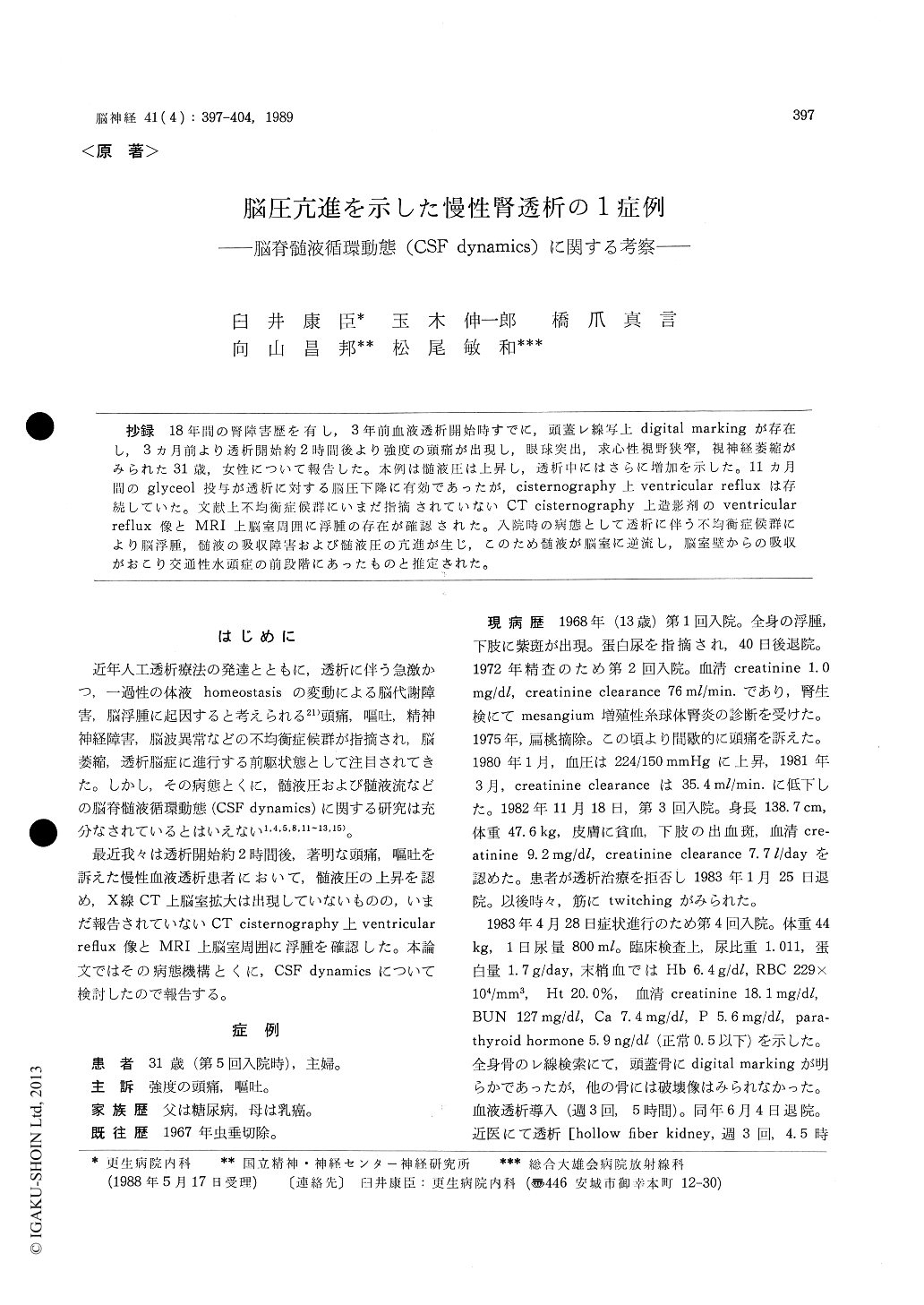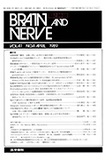Japanese
English
- 有料閲覧
- Abstract 文献概要
- 1ページ目 Look Inside
抄録 18年間の腎障害歴を有し,3年前血液透析開始時すでに,頭蓋レ線写上digital markingが存在し,3カ月前より透析開始約2時間後より強度の頭痛が出現し,眼球突出,求心性視野狭窄,視神経萎縮がみられた31歳,女性について報告した。本例は髄液圧は上昇し,透析中にはさらに増加を示した。11カ月間のglyceol投与が透析に対する脳圧下降に有効であったが,cisternography上ventricular refluxは存続していた。文献上不均衡症候群にいまだ指摘されていないCT cisternography上造影剤のventricularreflux像とMRI上脳室周囲に浮腫の存在が確認された。入院時の病態として透析に伴う不均衡症候群により脳浮腫,髄液の吸収障害および髄液圧の亢進が生じ,このため髄液が脳室に逆流し,脳室壁からの吸収がおこり交通性水頭症の前段階にあったものと推定ざれた。
There are many reports on the disequilibrium syndrome due to dialysis in patients with chronic renal failure. However, they do not mention the findings of CT cisternography and MRI. We in-tend to investigate the mechanism of CSF dynam-ics in a patient with disequilibrium syndrome by means of these radiological examinations.
A 31 years-old woman who had suffered from renal failure for 18 years was found to have pro-minent increase of serum creatinine (18. 1 mg/dl) and BUN (127 mg/dl) 3 years ago. At that time, digital marking of the skull was already present by X-ray examination without other destruction in bone survey of the whole body. She was hemo-dialysed by the hollow fiber kidney three times weekly (dialysis time 4. 5 hours, dialysate osmotic pressure 270 mOsm/kg H20). Three months ago, she began to complain of severe headache, nausea and vomiting 2 hours after the beginning of dia-lysis, so that she was referred to Kosei Hospital.
On admission, she showed exophthalmus, con-centric narrowing of the visual field, optic atrophyand hyperreflexia in jaw and four extremities. After admission, she received hemodialysis thera-py thrice weekly (dialysis time 5 hours, dialy-sate osmotic pressure 290 mOsm/kg H2O). At the same time, 200 ml of glyceol (contents of glycerin 10, fructose 5, NaC1 0.9%) was administrated in-travenously during dialysis, which ameliorated the symptoms of intracranial hypertension.
Laboratory studies revealed marked decrease of serum creatinine, BUN and uric acid levels and osmotic pressure, and increase of blood pH at the time of postdialysis compared with predialysis. Manometric CSF pressure increased up to 310 mmH20 at the day without dialysis before the glyceol administration. After admission, CSF pres-sure showed 240 mmH2O at the day without dialy-sis ; 270 mmH2O 2 hours after the start of dialysis with glyceol infusion ; 310 mmH20 2 hours after the start of dialysis without glyceol infusion. EEG became worse and showed S wave bursts after dialysis. Digital marking of the skull on X-ray increased in comparison with that 3 years previously. X-ray CT revealed slight cerebral atrophy without ventricular dilatation. In CT cisternography, there were ventricular reflux and dilatation. MRI showed presence of edema of the periventricular tissues and septum pellucidum.
After having received dialyses with the admi-nistration of glyceol, she had no headache, nausea or vomiting anymore. She continued receiving this prescription for the next 11 months without neurological problem. Recent examination show-ed CSF pressure 230-240 mmH20 at predialysis and the day without dialysis ; 160 mmH20 2 hours after the start of dialysis and 170 mmH20 at the postdialysis with glyceol infusion, having been accompanied with the improvement of EEG find-ings and without particular change of her labora-tory data including cisternography, except MRI which was not re-examined.
From these data, we infer abnormal CSF dy-namics as a possible cause of the disequilibrium syndrome ; rapid and transient alteration of body fluid contents and derangement of homeostasis originated by dialysis, give rise to cerebral edema and disturbance of absorption of CSF ; CSF flows into the ventricles inversely, and is absorbed from their walls. The brain of this patient might be the prodromal stage to the communicating hydro-cephalus. Even symptoms of the intracranial hy-pertension disappeared after administration of glyceol, the ventricular reflux was found to persist on cisternography. These evidence should be taken into account in hemodialysis therapy.

Copyright © 1989, Igaku-Shoin Ltd. All rights reserved.


